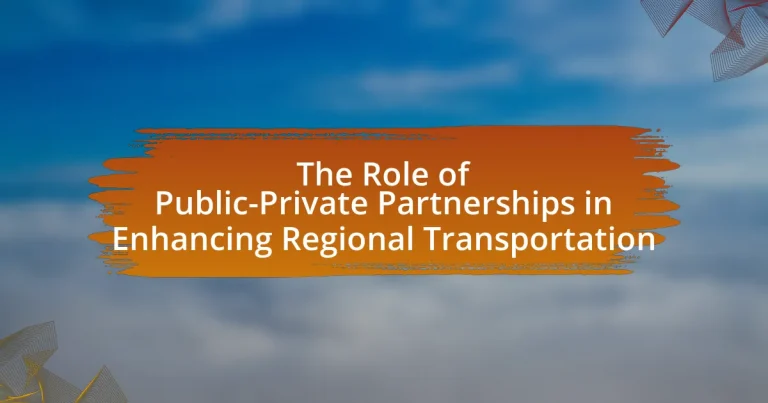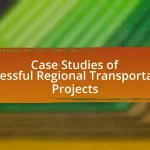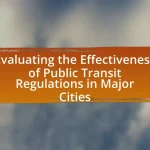Public-Private Partnerships (PPPs) play a crucial role in enhancing regional transportation by facilitating collaboration between government entities and private sector companies to finance, build, and operate transportation infrastructure projects. This article outlines how PPPs function within the transportation sector, highlighting their key components, benefits, and the challenges they address compared to traditional funding methods. It also examines the economic advantages of PPPs, their impact on job creation, and the importance of effective stakeholder collaboration. Furthermore, the article discusses future trends in PPPs, including sustainability and technology integration, while providing practical steps to enhance their effectiveness in regional transportation initiatives.
-in-Transportation-1.webp)
What are Public-Private Partnerships (PPPs) in Transportation?
Public-Private Partnerships (PPPs) in transportation are collaborative agreements between government entities and private sector companies to finance, build, and operate transportation infrastructure projects. These partnerships leverage private investment and expertise to enhance public transportation services, reduce costs, and improve efficiency. For instance, the U.S. Department of Transportation reported that PPPs can accelerate project delivery and provide innovative solutions, as seen in successful projects like the I-495 Capital Beltway Express Lanes in Virginia, which utilized private funding to expand capacity and improve traffic flow.
How do PPPs function within the transportation sector?
Public-Private Partnerships (PPPs) function within the transportation sector by facilitating collaboration between government entities and private companies to finance, build, and operate transportation infrastructure. This collaboration allows for the sharing of resources, risks, and expertise, which can lead to more efficient project delivery and innovation in service provision. For instance, in the United States, the I-495 Capital Beltway project in Virginia was developed through a PPP, resulting in improved traffic flow and reduced congestion, demonstrating the effectiveness of this model in enhancing regional transportation.
What are the key components of a successful PPP in transportation?
The key components of a successful Public-Private Partnership (PPP) in transportation include clear objectives, risk-sharing mechanisms, effective stakeholder engagement, and robust contractual frameworks. Clear objectives ensure that both public and private entities align on goals such as improving infrastructure, enhancing service delivery, or increasing efficiency. Risk-sharing mechanisms distribute financial and operational risks between partners, which is crucial for project viability; for instance, the UK’s Private Finance Initiative has demonstrated effective risk allocation in transportation projects. Effective stakeholder engagement involves collaboration with local communities and government entities to address concerns and gain support, as seen in successful PPPs like the Sydney Metro project. Lastly, robust contractual frameworks establish the terms of the partnership, including performance metrics and accountability measures, which are essential for maintaining project integrity and achieving desired outcomes.
How do stakeholders collaborate in transportation PPPs?
Stakeholders collaborate in transportation public-private partnerships (PPPs) through structured agreements that define roles, responsibilities, and resource sharing. This collaboration typically involves government entities, private companies, and community organizations working together to design, finance, construct, and operate transportation projects. For instance, the U.S. Department of Transportation has highlighted successful PPPs, such as the I-595 Corridor Improvements Project in Florida, where stakeholders engaged in joint planning and risk-sharing to enhance project efficiency and reduce costs. This collaborative approach allows for leveraging private sector innovation and funding while ensuring public interests are met, ultimately leading to improved transportation infrastructure and services.
Why are PPPs important for regional transportation?
Public-Private Partnerships (PPPs) are important for regional transportation because they leverage private sector investment and expertise to improve infrastructure and service delivery. By combining public oversight with private efficiency, PPPs can accelerate project completion, reduce costs, and enhance service quality. For instance, a study by the World Bank found that PPPs can reduce project costs by up to 20% and shorten delivery times by 30%, making them a vital mechanism for addressing the growing demands on regional transportation systems.
What challenges do traditional funding methods face in transportation?
Traditional funding methods in transportation face significant challenges, including budget constraints, inefficiencies, and a lack of flexibility. Budget constraints arise from limited public funding sources, which often fail to meet the growing demands for infrastructure improvements. Inefficiencies are evident in the lengthy approval processes and bureaucratic hurdles that delay project implementation. Additionally, traditional funding lacks the flexibility to adapt to changing economic conditions or emerging technologies, making it difficult to respond to evolving transportation needs. These challenges hinder the ability to maintain and expand transportation networks effectively.
How do PPPs address these challenges effectively?
Public-Private Partnerships (PPPs) effectively address challenges in regional transportation by leveraging the strengths of both sectors to enhance infrastructure development and service delivery. PPPs combine public sector oversight with private sector efficiency and innovation, resulting in improved project financing, risk-sharing, and operational expertise. For instance, a study by the World Bank indicates that PPPs can reduce project costs by 20% to 30% compared to traditional public procurement methods, thereby accelerating the delivery of essential transportation projects. Additionally, PPPs facilitate access to private capital, which is crucial for funding large-scale infrastructure initiatives that governments may struggle to finance alone. This collaborative approach not only enhances service quality but also ensures that projects are completed on time and within budget, ultimately leading to more effective regional transportation systems.
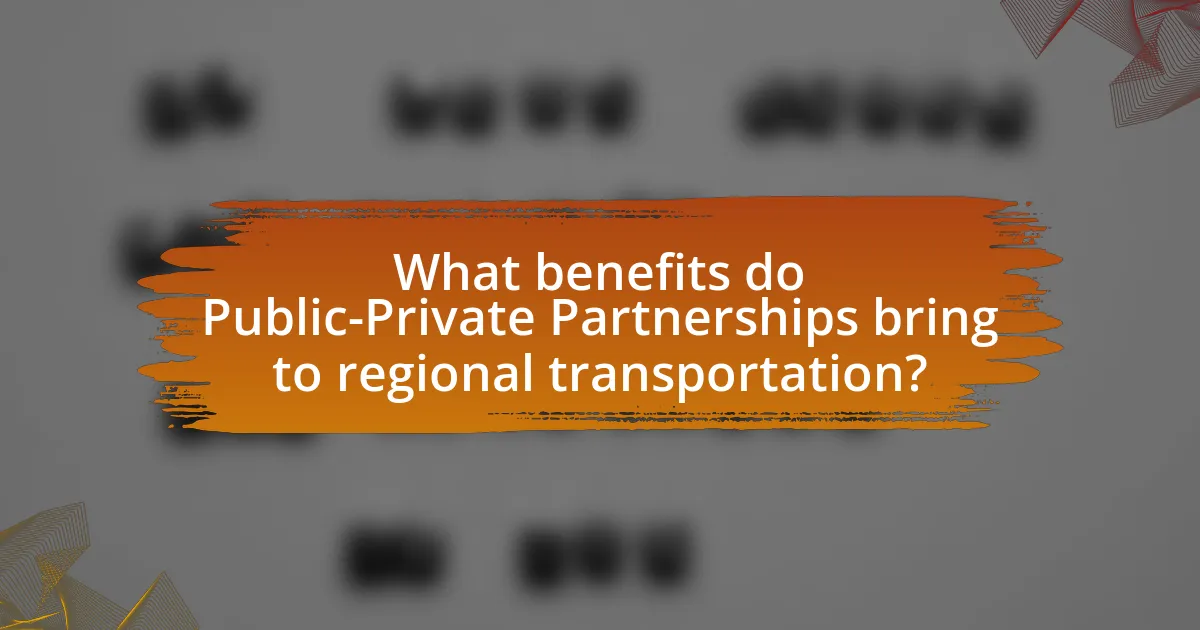
What benefits do Public-Private Partnerships bring to regional transportation?
Public-Private Partnerships (PPPs) enhance regional transportation by leveraging private sector efficiency and innovation alongside public sector oversight and funding. These collaborations often result in improved infrastructure quality, reduced project costs, and accelerated project delivery timelines. For instance, a study by the World Bank found that PPPs can reduce construction time by 20-30% compared to traditional public procurement methods. Additionally, PPPs can attract private investment, which alleviates the financial burden on public budgets, allowing for more extensive and diverse transportation projects. This combination of resources and expertise ultimately leads to better service delivery and increased accessibility for communities.
How do PPPs enhance infrastructure development?
Public-Private Partnerships (PPPs) enhance infrastructure development by leveraging private sector investment and expertise to deliver public projects more efficiently. This collaboration allows for the sharing of risks and resources, resulting in faster project completion and improved quality of infrastructure. For instance, a study by the World Bank indicates that PPPs can reduce project costs by 20% to 30% compared to traditional public procurement methods. Additionally, PPPs often incorporate innovative technologies and management practices, which can lead to more sustainable and resilient infrastructure solutions.
What types of transportation projects benefit most from PPPs?
Transportation projects that benefit most from Public-Private Partnerships (PPPs) include large-scale infrastructure developments such as toll roads, bridges, and transit systems. These projects often require significant capital investment and risk-sharing, which PPPs facilitate by leveraging private sector efficiency and innovation. For instance, the I-595 Corridor Improvements Project in Florida, which utilized a PPP model, successfully reduced construction time and costs while enhancing service delivery. This demonstrates that PPPs are particularly effective in complex transportation initiatives where public funding alone may be insufficient or inefficient.
How do PPPs improve project delivery timelines?
Public-Private Partnerships (PPPs) improve project delivery timelines by leveraging the efficiency and expertise of the private sector in managing and executing infrastructure projects. This collaboration allows for faster decision-making processes, streamlined project management, and access to innovative technologies, which collectively reduce delays. For instance, a study by the World Bank found that projects delivered through PPPs can be completed 20% faster than those executed solely by public entities, primarily due to the private sector’s ability to mobilize resources and implement best practices in project execution.
What economic advantages do PPPs provide?
Public-Private Partnerships (PPPs) provide significant economic advantages by leveraging private sector efficiency and investment to enhance public infrastructure projects. These partnerships can reduce public expenditure by sharing costs and risks, allowing governments to allocate resources more effectively. For instance, a study by the World Bank indicates that PPPs can lead to cost savings of 10-20% in infrastructure projects due to improved project management and innovation brought by private entities. Additionally, PPPs can stimulate economic growth by attracting private investment, which can lead to job creation and increased productivity in the region.
How do PPPs leverage private investment for public good?
Public-Private Partnerships (PPPs) leverage private investment for public good by combining public sector objectives with private sector efficiency and capital. This collaboration allows for the financing, construction, and operation of public infrastructure projects, such as transportation systems, where private entities invest their resources in exchange for a return on investment through user fees or government payments. For instance, the U.S. Department of Transportation reported that PPPs have facilitated over $200 billion in infrastructure investments, enhancing regional transportation networks while reducing the financial burden on taxpayers.
What impact do PPPs have on job creation in the transportation sector?
Public-Private Partnerships (PPPs) significantly enhance job creation in the transportation sector by facilitating large-scale infrastructure projects that require substantial labor. For instance, a study by the World Bank indicates that PPPs can create up to 30% more jobs compared to traditional public procurement methods due to their efficiency and ability to leverage private sector investment. This job creation occurs not only during the construction phase but also in the long-term operation and maintenance of transportation systems, contributing to sustainable employment opportunities.
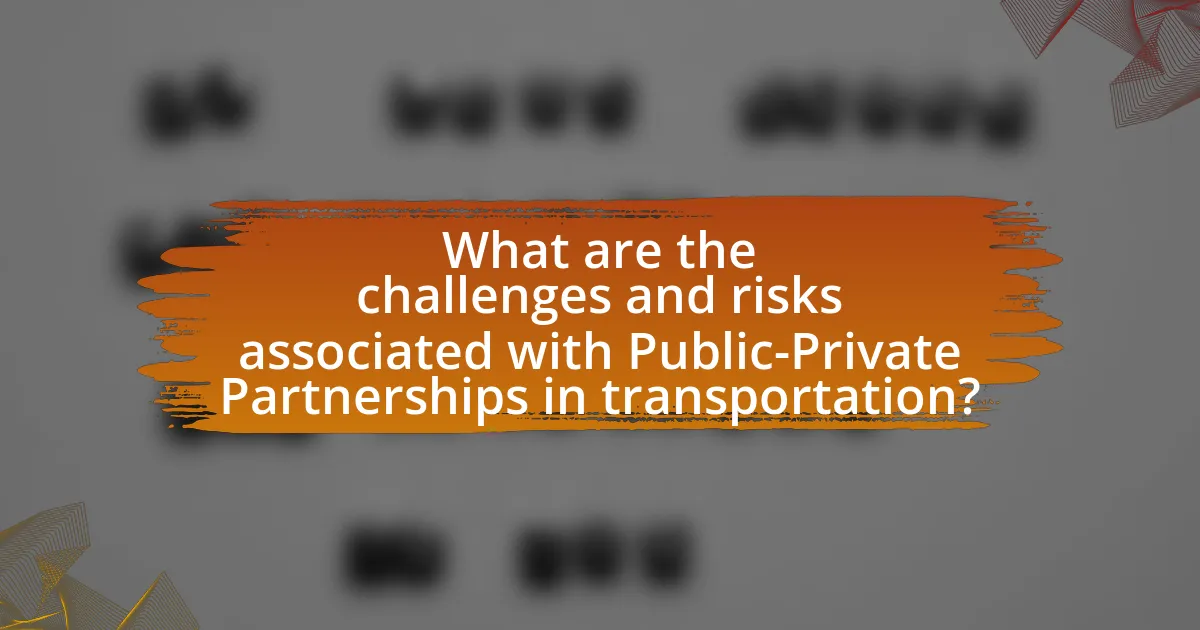
What are the challenges and risks associated with Public-Private Partnerships in transportation?
Public-Private Partnerships (PPPs) in transportation face several challenges and risks, including financial instability, misalignment of interests, and regulatory hurdles. Financial instability arises when private entities encounter unexpected costs or revenue shortfalls, which can jeopardize project viability. Misalignment of interests occurs when public sector goals, such as accessibility and affordability, conflict with private sector objectives focused on profit maximization. Regulatory hurdles can delay project approvals and increase costs due to complex compliance requirements. According to a report by the World Bank, approximately 50% of PPP projects in transportation experience significant delays, highlighting the impact of these challenges on project execution and effectiveness.
What common pitfalls do PPPs encounter in regional transportation projects?
Public-Private Partnerships (PPPs) in regional transportation projects commonly encounter pitfalls such as misalignment of objectives, inadequate risk allocation, and insufficient stakeholder engagement. Misalignment of objectives occurs when public and private partners have differing goals, leading to conflicts and inefficiencies. Inadequate risk allocation can result in one party bearing disproportionate risks, which may deter investment and affect project viability. Insufficient stakeholder engagement often leads to public opposition and delays, as local communities may feel excluded from the decision-making process. These pitfalls have been documented in various studies, including the “Public-Private Partnerships: Lessons from the UK” report by the National Audit Office, which highlights the importance of aligning interests and engaging stakeholders for successful project outcomes.
How can misalignment of goals between public and private sectors affect outcomes?
Misalignment of goals between public and private sectors can lead to inefficient resource allocation and suboptimal project outcomes. When public entities prioritize social welfare and long-term community benefits, while private companies focus on profit maximization, the resulting disconnect can hinder effective collaboration. For instance, a study by the World Bank highlights that misaligned objectives in public-private partnerships often result in delays, increased costs, and unmet project specifications, ultimately affecting service delivery and user satisfaction in regional transportation initiatives.
What are the financial risks involved in transportation PPPs?
The financial risks involved in transportation Public-Private Partnerships (PPPs) include revenue risk, cost overruns, financing risk, and demand risk. Revenue risk arises when projected income from tolls or service fees does not meet expectations, impacting the project’s financial viability. Cost overruns occur when actual project costs exceed initial estimates, which can strain budgets and lead to financial instability. Financing risk pertains to the challenges in securing adequate funding or unfavorable financing terms, which can hinder project execution. Demand risk involves fluctuations in user demand that can affect revenue generation, particularly in projects reliant on traffic volumes. These risks are critical considerations for stakeholders in transportation PPPs, as evidenced by various case studies highlighting financial challenges faced in projects like the Denver Eagle P3 and the Indiana Toll Road lease.
How can these challenges be mitigated?
Public-private partnerships (PPPs) can mitigate challenges in regional transportation by fostering collaboration between government entities and private sector stakeholders. This collaboration enables shared resources, expertise, and risk management, leading to more efficient project execution. For instance, a study by the National Cooperative Highway Research Program found that PPPs can reduce project delivery times by up to 30% compared to traditional procurement methods. Additionally, leveraging private investment can alleviate budget constraints faced by public agencies, allowing for the development of critical infrastructure without overburdening taxpayers. By establishing clear communication channels and performance metrics, PPPs can also enhance accountability and ensure that projects meet community needs effectively.
What best practices can be implemented for successful PPPs?
Successful public-private partnerships (PPPs) can be achieved by implementing best practices such as establishing clear objectives, fostering open communication, and ensuring equitable risk-sharing. Clear objectives align the interests of both public and private entities, facilitating a common understanding of project goals. Open communication promotes transparency and trust, which are essential for collaboration. Equitable risk-sharing ensures that both parties are invested in the project’s success, reducing the likelihood of conflicts. According to the World Bank, projects that adhere to these best practices are more likely to meet their intended outcomes and deliver value to the community.
How can effective communication between stakeholders reduce risks?
Effective communication between stakeholders reduces risks by ensuring that all parties have a clear understanding of project goals, expectations, and potential challenges. When stakeholders, such as government agencies, private companies, and community members, engage in open dialogue, they can identify and address issues early, minimizing misunderstandings that could lead to project delays or failures. For instance, a study by the Project Management Institute found that projects with effective stakeholder communication are 20% more likely to meet their objectives and stay within budget, demonstrating that proactive communication directly correlates with reduced risks in project execution.
What are the future trends for Public-Private Partnerships in regional transportation?
Future trends for Public-Private Partnerships (PPPs) in regional transportation include increased investment in sustainable infrastructure, enhanced technology integration, and a focus on community engagement. As governments prioritize sustainability, PPPs are likely to facilitate projects that promote green transportation solutions, such as electric public transit systems and bike-sharing programs. The integration of advanced technologies, including smart traffic management systems and data analytics, will improve operational efficiency and user experience. Furthermore, engaging local communities in the planning and decision-making processes will ensure that transportation projects meet the specific needs of residents, fostering greater public support and collaboration. These trends are supported by recent studies indicating that PPPs can effectively mobilize private capital and expertise to address regional transportation challenges while aligning with broader environmental and social goals.
How is technology influencing the evolution of PPPs in transportation?
Technology is significantly influencing the evolution of Public-Private Partnerships (PPPs) in transportation by enhancing efficiency, transparency, and innovation. Advanced technologies such as data analytics, smart infrastructure, and digital communication tools enable better project management and stakeholder engagement. For instance, the integration of real-time data collection and analysis allows for more informed decision-making, optimizing resource allocation and improving service delivery. Additionally, technologies like blockchain enhance transparency in transactions and contract management, reducing the risk of corruption and increasing trust among partners. The adoption of smart transportation systems, including connected vehicles and intelligent traffic management, further illustrates how technology drives innovation in PPPs, leading to improved transportation networks and user experiences.
What role do sustainability and environmental considerations play in future PPPs?
Sustainability and environmental considerations are critical in shaping future public-private partnerships (PPPs) by ensuring that infrastructure projects minimize ecological impact and promote long-term viability. These considerations drive the integration of green technologies and practices, such as renewable energy sources and sustainable materials, into transportation projects. For instance, the Global Infrastructure Facility emphasizes that incorporating sustainability into PPPs can lead to reduced carbon footprints and enhanced resilience against climate change. Furthermore, studies indicate that projects prioritizing environmental factors often achieve better community acceptance and regulatory compliance, ultimately leading to more successful outcomes.
What practical steps can be taken to enhance the effectiveness of PPPs in regional transportation?
To enhance the effectiveness of Public-Private Partnerships (PPPs) in regional transportation, stakeholders should implement clear communication strategies among all parties involved. Effective communication fosters transparency, aligns objectives, and builds trust, which are essential for successful collaboration. Research indicates that projects with strong stakeholder engagement and communication plans are 30% more likely to meet their objectives on time and within budget. Additionally, establishing performance metrics and accountability frameworks can ensure that both public and private entities are held responsible for their contributions, leading to improved project outcomes.
